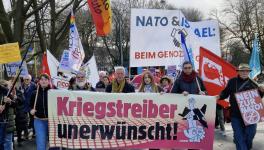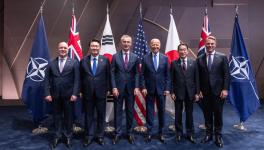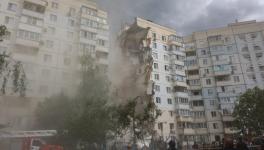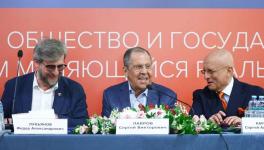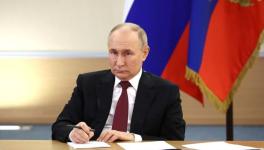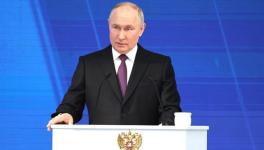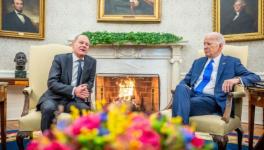Ukraine’s Revenge on the West
Russian Duma ratified the accession of four Ukrainian territories into the Federation, Moscow, October 3, 2022
Russian Duma’s ratification of the annexation of four regions of Ukraine (Donetsk and Lugansk People’s Republics, as well as the Kherson and Zaporozhye Regions) and the adoption of the relevant laws thereof creates a new dynamic and will take time to create a new balance of forces on the ground.
Meanwhile, the external environment is also phenomenally transforming. The deepening energy crisis in Europe following the sabotage of the Nord Stream gas pipelines becomes a serious contradiction.
Thus, a complex situation presents itself against the backdrop of a massive Russian military build-up around Ukraine in the Kharkov region and in the southern Black Sea region with long convoys of armour reportedly heading toward Crimea from Russia.
The Duma’s unanimous ratification of the accession of four regions to Russia on Monday was to be expected, the relevant legislation was duly ratified on Tuesday by the Federation Council (the upper house of the parliament), and, President Putin signed them off into law. The annexed Ukrainian regions have become part of Russia.
The Duma approved the government’s proposals on the establishment of the new regions’ borders. The relevant treaties outline that the borders adjacent to the territory of a foreign country will be Russia’s new state border. Plainly put, the old boundaries of the Soviet era are being restored in those regions.
The determination of the boundaries has security implications. In the Donbass, there are vast areas that still remain under the control of the Ukrainian forces.
Liman city in Donetsk Republic was captured by the Ukrainian forces only three days ago. The Ukrainian incursions into Kherson continue. Heavy fighting is reported. Evidently, much unfinished business remains for Moscow.
The Zaporozhye Region (which also happens to be an important littoral region on the Azov Sea and forms a part of what Russians historically call “Novorossiya”), is another priority where the capital city of the oblast itself is not yet under Russian control.
In the emergent situation, Ukraine President Zelensky formally applied for Ukraine’s NATO membership on an expeditious basis, but within hours, the alliance poured cold water on it explaining that any decision will require support from all 30 member states, signalling, in effect, that there isn’t going to be any direct NATO intervention in Ukraine.
However, the White House readout on President Biden’s call with Zelensky on Monday mentioned a new $625 million security assistance package by Washington that includes additional weapons and equipment, including HIMARS, artillery systems and ammunition, and armoured vehicles. Biden “pledged to continue supporting Ukraine as it defends itself from Russian aggression for as long as it takes.”
Later, US Secretary of State Antony Blinken said that “Recent developments… only strengthens our resolve.” He added, “The capabilities we are delivering are carefully calibrated to make the most difference on the battlefield and strengthen Ukraine’s hand at the negotiating table when the time is right.”
The Russian military command will probably have to reset the parameters of the special military operations since its forces will henceforth be safeguarding the country’s territorial integrity and sovereignty. What form its takes remains to be seen. So far, the actual Russian deployment has been less than 100,000 troops.
Certainly, the induction of 300,000 troops with previous military experience will impact the overall military balance to Russia’s advantage. Defence Minister Sergey Shoigu has said that another 70,000 men have also volunteered, which will put the total strength of the additional forces at around 370,000.
Now, that is a huge increase. Therefore, it is entirely conceivable that the old pattern of “grinding” the Ukrainian forces may change and the objective will be to end the war decisively.
The US decision to set up a command centre outside Ukraine (in Germany) seems to anticipate Russian attacks on command centres in Kiev and elsewhere with much bigger use of airpower.
A point of no return is fast approaching from where Russia will have no alternative but to push for a regime change in Kiev and pave the way for an altogether new Ukrainian leadership that shakes off the Anglo-American grip and is willing to negotiate to end the war.
The attention in Europe is turning more and more towards the economic crisis with looming double-digit inflation and recession. The growing public discontent is turning into protests in many European countries already. The crisis can only deepen once winter sets in.
Conceivably, the shift in the popular mood may prompt the European governments to concentrate on their domestic issues. The most ardent votary of open-ended war with Russia is Britain, but Prime Minister Liz Truss is fighting for political survival and the Conservatives have forfeited their mandate to rule.
In Germany, the Centre-Right Christian Democratic Union/Christian Social Union opposition bloc in the Bundestag stalled a motion urging the government to “immediately” allow the export of German battle tanks and infantry fighting vehicles to Ukraine. Politico reported that “A vote on weapons deliveries in the Bundestag would have risked revealing fatal cracks in the government unity and could even have led to a defeat of (Chancellor Olaf) Scholz in parliament.”
The German government also faces mounting pressure from the Eastern European allies. The Foreign Policy magazine in Washington wrote last week, “In the eyes of Berlin’s NATO allies in Eastern Europe, particularly the countries that border Russia, Germany, the economic and political power centre of Europe, isn’t doing nearly enough. And the longer it delays, the more it risks a long-term diplomatic fracture with those allies in the East.”
In this fluid situation, the sabotage of the Nord Stream gas pipeline dovetails into the energy crisis in Europe and threatens European countries with “de-industrialisation.” For Germany, in particular, the country’s economic model is riveted on the availability of abundant gas supplies from Russia at cheap prices supplied through pipelines. Clearly, the sabotage of the Nord Stream has monumental implications.
Europe needs energy security in the short and medium term without also wrecking climate targets. It means heightened geopolitical sensitivity. On Monday, Russian energy giant Gazprom proposed to European gas customers that part of the damaged Nord Stream network could still transport fuel — but only on the newly constructed Nord Stream 2.
A Gazprom statement in its Telegram account said that one of the three lines of the Nord Stream 2 remains unaffected and the gas giant has lowered the pressure to inspect the link for damage and potential leaks. Nord Stream 2 has a shipment capacity of 55 billion cubic meters per year, which means its line B could deliver as much as 27.5 billion cubic meters per year to Germany across the Baltic Sea. However, the Nord Stream 2 requires EU approval, which is problematic given the tensions between Brussels and Moscow.
The ascendancy of the Atlanticists in the echelons of power in Berlin and their nexus with the EU bureaucrats in Brussels has so far worked splendidly for Washington. But the ground beneath the feet is shifting, as the dramatic turn in Italy’s politics shows. In France, President Macron is immobilised, lacking a parliamentary majority to legislate, and is being worn down by serial crises. What all this means is that the three main power centres within the Eurozone (Germany, France and Italy) and Britain are entering a period of deep crisis. Their capacity or level of interest to fight Russia in Ukraine is getting severely limited.
Looking back at the 2014 coup in Kiev and the West’s rupture with Russia, a new geopolitical landscape is forming in Europe. The European Political Community summit which began at the Prague Castle today, serves to highlight that this is a Kafkaesque moment — one last Hurrah for European integration. This must be Ukraine’s revenge on Europe for staging the 2014 coup, which cut the umbilical cord binding it with Russia.
MK Bhadrakumar is a former diplomat. He was India’s ambassador to Uzbekistan and Turkey. The views are personal.
Get the latest reports & analysis with people's perspective on Protests, movements & deep analytical videos, discussions of the current affairs in your Telegram app. Subscribe to NewsClick's Telegram channel & get Real-Time updates on stories, as they get published on our website.










